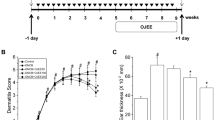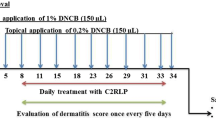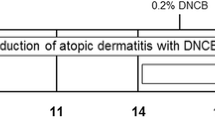Abstract
Fingerroot [Boesenbergia pandurata (Roxb.) Schltr.], belonging to Zingiberaceae, is traditionally used as a spice and for medicinal purposes. In this study, the effects of ethanol extracts of fingerroot on atopic dermatitis (AD) were investigated using hairless mice treated with oxazolone. Oral administration of fingerroot extract (BPE) attenuated dermatitis associated with barrier damage as determined by transepidermal water loss, erythema, and filaggrin expression. Furthermore, infiltration of inflammatory cells and epidermal thickness in the skin was markedly decreased with BPE. BPE significantly decreased serum immunoglobulin (Ig) E and interleukin (IL)-4 levels, but increased IgG2a and interferon (IF)-γ levels. In addition, BPE decreased cytokines and chemokines associated with T helper type 1 (Th1) and type 2 (Th2) cells, and inflammation-associated molecules in the skin. BPE also decreased Th2-associated molecules and increased Th1/regulatory T cell-associated molecules in the spleen. These results suggest that BPE could be a useful functional ingredient in AD treatments.
Similar content being viewed by others
References
Boguniewicz M, Leung DY. Atopic dermatitis: A disease of altered skin barrier and immune dysregulation. Immunol. Rev. 242: 233–246 (2011)
Niebuhr M, Werfel T. Innate immunity, allergy, and atopic dermatitis. Curr. Opin. Allergy Cl. Immunol. 10: 463–468 (2010)
Barnes PJ. Role of GATA-3 in allergic diseases. Curr. Mol. Med. 8: 330–334 (2008)
Zheng T, Yu J, Oh MH, Zhu Z. The atopic march: Progression from atopic dermatitis to allergic rhinitis and asthma. Allergy Asthma Immunol. Res. 3: 67–73 (2011)
De-Benedetto A, Kubo A, Beck LA. Skin barrier disruption: A requirement for allergen sensitization? J. Invest. Dermatol. 132: 949–963 (2012)
Howell MD, Kim BE, Gao P, Grant AV, Boguniewicz M, DeBenedetto A, Schneider L, Beck LA, Barnes KC, Leung DY. Cytokine modulation of atopic dermatitis filaggrin skin expression. J. Allergy Clin. Immun. 124: R7–R12 (2009)
Kubo A, Nagao K, Amagai M. Epidermal barrier dysfunction and cutaneous sensitization in atopic diseases. J. Clin. Invest. 122: 440–447 (2012)
Szegedi A, Baráth S, Nagy G, Szodoray P, Gál M, Sipka S, Bagdi E, Banham AH, Krenács L. Regulatory T cells in atopic dermatitis: Epidermal dendritic cell clusters may contribute to their local expansion. Brit. J. Dermatol. 160: 984–993 (2009)
Gloire G, Legrand-Poels S, Piette J. NF-κB activation by reactive oxygen species: Fifteen years later. Biochem. Pharmacol. 72: 1493–1505 (2006)
Aiba S, Manome H, Yoshino Y, Tagami H. Alteration in the production of IL-10 and IL-12 and aberrant expression of CD23, CD83, and CD86 by monocytes or monocyte-derived dendritic cells from atopic dermatitis patients. Exp. Dermatol. 12: 86–95 (2003)
Trakoontivakorn G, Nakahara K, Shinmoto H, Takenaka M, Onishi-Kameyama M, Ono H. Structural analysis of a novel antimutagenic compound, 4-hydroxypanduratin A, and the antimutagenic activity of flavonoids in a Thai spice, fingerroot (Boesenbergia pandurata Schult.) against mutagenic heterocyclic amines. J. Agr. Food Chem. 49: 3046–3050 (2001)
Mahidol C, Tantiwachwuttikul P, Reutrakul V, Taylor WC. Constituents of Boesenbergia pandurata (syn. Kaempferia pandurata) III Isolation and synthesis of (+)-boesenbergin B. Aust. J. Chem. 37: 1739–1745 (1984)
Choi YR. Inhibitory effects of Boesenbergia pandurata Roxb. and its active compound panduratin a on allergy-related mediator production in rat basophilic leukemia mast cells. MS thesis, Yonsei University, Seoul, Korea (2011)
Kim DY, Kim MS, Sa BK, Kim MB, Hwang JK. Boesenbergia pandurata attenuates diet-induced obesity by activating AMPactivated protein kinase and regulating lipid metabolism. Int. J. Mol. Sci. 13: 994–1005 (2012)
Shim JS, Kwon YY, Hwang JK. The effects of panduratin A isolated from Kaempferia pandurata Roxb. on the expression of matrix metalloproteinase-1 and type-1 procollagen in human skin fibroblasts. Planta Med. 74: 239–244 (2008)
Park EJ, Park KC, Eo H, Seo J, Son M, Kim KH, Chang YS, Cho SH, Min KU, Jin M, Kim S. Suppression of spontaneous dermatitis in NC/Nga murine model by PG102 isolated from Actinidia arguta. J. Invest. Dermatol. 127: 1154–1160 (2007)
Rautajoki KJ, Kylaniemi MK, Raghav SK, Rao K, Lahesmaa R. An insight into molecular mechanisms of human T helper cell differentiation. Ann. Med. 40: 322–335 (2008)
Wegmann M. Th2 cells as targets for therapeutic intervention in allergic bronchial asthma. Expert Rev. Mol. Diagn. 9: 85–100 (2009)
Takatsu K, Nakajima H. IL-5 and eosinophilia. Curr. Opin. Immunol. 20: 288–294 (2008)
Ezzat MH, Hasan ZE, Shaheen KY. Serum measurement of interleukin-31 (IL-31) in paediatric atopic dermatitis: Elevated levels correlate with severity scoring. J. Eur. Acad. Dermatol. Venereol. 25: 334–339 (2011)
Homey B, Meller S, Savinko T, Alenius H, Lauerma A. Modulation of chemokines by staphylococcal superantigen in atopic dermatitis. Chem. Immunol. Allergy 93: 181–194 (2007)
Pickard C, Smith AM, Cooper H, Strickland I, Jackson J, Healy E, Friedmann PS. Investigation of mechanisms underlying the T-cell response to the hapten 2,4-dinitrochlorobenzene. J. Invest. Dermatol. 127: 630–637 (2007)
Sumiyoshi K, Nakao A, Ushio H, Mitsuishi K, Okumura K, Tsuboi R, Ra C, Ogawa H. Transforming growth factor-β1 suppresses atopic dermatitis-like skin lesions in NC/Nga mice. Clin. Exp. Allergy 32: 309–314 (2002)
Akdis CA, Akdis M. Mechanisms of allergen-specific immunotherapy. J. Allergy Clin. Immun. 127: 18–27 (2011)
Homey B, Steinhoff M, Ruzicka T, Leung DY. Cytokines and chemokines orchestrate atopic skin inflammation. J. Allergy Clin. Immun. 118: 178–189 (2006)
Yanti, Anggakusuma, Gwon SH, Hwang JK. Kaempferia pandurata Roxb. inhibits Porphyromonas gingivalis supernatant-induced matrix metalloproteinase-9 expression via signal transduction in human oral epidermoid cells. J. Ethnopharmacol. 123: 315–324 (2009)
Author information
Authors and Affiliations
Corresponding author
Rights and permissions
About this article
Cite this article
Kim, MS., Pyun, HB. & Hwang, JK. Effects of orally administered fingerroot (Boesenbergia pandurata) extract on oxazolone-induced atopic dermatitis-like skin lesions in hairless mice. Food Sci Biotechnol 22 (Suppl 1), 257–264 (2013). https://doi.org/10.1007/s10068-013-0075-z
Received:
Revised:
Accepted:
Published:
Issue Date:
DOI: https://doi.org/10.1007/s10068-013-0075-z




